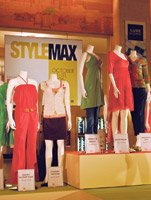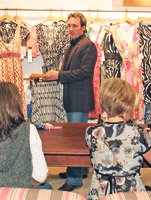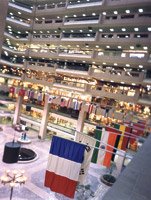A Niche in Time...
Regional marts re-tool to build market share Regional markets are undergoing tremendous change, from a growing emphasis on the contemporary and higher end of the apparel market to even re-imagining how a marketplace should function.
The California Apparel News caught up with executives from Atlanta, Chicago, Dallas, and Los Angeles to talk about their new changes and the overall direction of regional marts.
Chicago Merchandise Mart Susan McCullough, senior vice president, apparel
CAN: What’s new with the Chicago show?SM: The biggest news is that we have four StyleMax shows per year now. It used to be two, so we have a show for every season now. We’ve also transitioned our business away from permanent showrooms and into trade shows, and StyleMax is our premier buying event.
We still have permanent showrooms in the Chicago Apparel Center, which are there on a daily basis. But during our market week, it’s all about our trade show on the seventh floor of the Merchandise Mart in a state-of-the-art trade show facility.
CAN: Why the change?SM: We think it’s the wave of the future, and that the best way for buyers to buy is in an open-booth, show environment. We think the showrooms are kind of an outdated principle that doesn’t really apply anymore, and that there’s a better way to do business.
CAN: What have you heard from buyers?SM: It’s a much easier environment in which to shop. Everything’s out in the open, you can walk the aisles, and within a few minutes get a feeling for what the trends are, see new lines, as opposed to having to cross the threshold of someone’s showroom. It’s kind of an intimidating thing to go in, whereas you can stand in the aisle and look at a line. It’s a cleaner, easier, more productive way to shop; you can see a whole lot in less time.
It also brings a lot of lines to the marketplace that wouldn’t ordinarily be there. Certainly a permanent showroom is a huge commitment to a company, whereas coming in for four days into a temporary space isn’t.
CAN: Have you seen a resulting increase in traffic?SM: It’s been huge. We have many more vendors and many more stores coming because of the vendors. We have about 200,000 square feet of exhibit space with between 400 and 500 exhibitors with 6,000 lines.
CAN: What are you doing to draw more marquee names?SM: We launched something called Pure Contemporary at StyleMax, which is a whole area dedicated to contemporary with a whole lot of bells and whistles, and that helped us bring in some new lines.
CAN: Tell us about the Chicago Collective for Menswear.SM: This August, we launched something called Level 8, which is a show within a show for contemporary menswear, and that’s been quite successful. I think it’s something menswear stores need to take a look at. A lot of these wonderful haberdasheries really need to look at finding younger customers, and we’re trying to help them skew younger. And there’s also a plethora of new stores that are just for contemporary menswear, and we want to have the appropriate menswear for them.
America’s Mart, Atlanta Lawton Hall, senior vice president
CAN: What’s new with the show?LH: We’ve had an incredibly strong response to expanding our Premiere show, which is the higher-end product. We’ve doubled the amount of booths just in the last year, and we’ve gone to five shows per year. Originally it was just two, but the demand was such we’ve made Premiere available for all five shows.
CAN: What are some of the marquee names you have in Premiere?LH: We started out with people like True Religion, Saja, Paige Denim—they’ve all moved into permanent spaces now. We had a company called Tuzzi, from Canada, which did incredibly well at the last show, and they’re now in a permanent room. It’s a wide variety: Premiere has the updated, contemporary missy product, and then the high-end contemporary—a lot of which is designed in L.A.—and then we also have higher-end accessories on that floor.
CAN: Is part of it that the South is becoming more fashionable?LH: Strip malls are booming in the Southeast now, and most of them have smaller boutiques in the higher-end, contemporary market. The traditional missy market seems to be becoming more and more department store.
CAN: Tell us about your new shoe floor.LH: We’ve also launched a shoe floor with 80 to 100 booths of fashion shoes that apparel stores are carrying. A lot of traditional shoe retailers have become very competitive with the discounters, so shoe companies are interested in selling to fashion apparel boutiques. And the boutiques are interested in shoes because they go with the outfits they carry, so it’s been a great success. And that’s unique to Atlanta—no other show in the country has singled out shoes on its own floor.
Retailers are finding it’s very easy to sell fashion shoes. Women buy an outfit and buy the shoes that go with it. It’s an additional sale for the boutique, and it’s very easy for the consumer because [its] one-stop shopping. Conversely, a lot of shoe stores are coming in now and buying apparel and accessories to stay competitive.
CAN: What else is new?LH: In the 9th-floor permanent area, we’ve launched a scenic co-op. These are large showrooms that are subdivided into small spaces where you lease a space that’s part of one big presentation. The original co-op had headlines like Single, Project E, Joie, Paper Denim & Cloth. We’ve had a waiting list for about a year, so we’ve expanded to a second co-op that will open in February 2007 with brands like James’ Jeans, Mint, Twelfth Street by Cynthia Vincent, and Saja. They don’t need a lot of space, and it’s an exciting environment.
CAN: What’s the breakdown of permanent versus temporary showrooms?LH: We have about 600 [permanent] showrooms, and we average about 600 temporary booths per show.
CAN: What industry trends have you noticed?LH: Accessories are very profitable for any apparel boutique, so we’re looking for unique product—the kind that’s not found in department stores. So we’re looking at industry trends along these lines, where you find that some people carry gift products and that sort of thing.
Another area where we’re really growing is in the intimate apparel category. We’re expanding that both in Premiere and in our permanent showrooms upstairs. It’s not traditional lingerie—they want to be called intimate apparel now. It’s becoming a fashion trend, not just undergarments.
Dallas Market Center Cole Daugherty, vice president of marketing communications
CAN: What’s new with the show?CD: The biggest operational change coming down the road is changing our market date pattern. We’re moving to a Sunday– Wednesday date pattern starting January 28–31, 2007. The reason is that it’s what our buyers have been asking for. We polled our retailers, and the survey came back with 83 percent preferring a Sunday–Wednesday pattern rather than Thursday–Monday.
Feedback has been outstanding. Retailers have told us they’re looking forward to spending more time at the market, because Saturday and Sunday are the biggest days in retail—previously they got into the market, then got out.
Since 9/11 people are spending more time at home with their families on the weekends, or concentrating on their stores.
CAN: What about your temporary section?CD: We’re still expanding our temporaries. We opened a new apparel venue in 2003 called FashionCenterDallas, and since that time we’ve seen an expanding number of temps come into our marketplace. It’s great for our retailers because they’re always looking for something new, and it’s also served as a great incubator for emerging lines.
We also launched shared showrooms for temporaries in the middle of the contemporary neighborhood. We’re calling it Studio 15, because it’s on the 15th floor. If October market was any indication, I think it’s going to prove to be quite popular. We have about 550 permanent showrooms and 500 temps.
CAN: What are you doing to keep attendance up?CD: Any market is dependent upon product first and foremost, and Dallas offers the widest array of product for the apparel store. Number two is customer service; in addition to a convenient location, we offer first-rate service for the buyers. Special marketing efforts we’re undertaking include retail development programs that are expanding our retail base. We’re seeing more retailers from a wider area come to Dallas to source apparel, and it’s incumbent upon us to make them feel welcome.
CAN: What industry trends are you noticing?CD: One of the hallmarks of Dallas Market Center is that retailers can enjoy the unique ability to buy into gift and home accessories products. A lot of specialty stores these days are stocking gift and personal-care products to diversify their mix. We’re finding that retailers are cross-buying with increasing frequency, so it’s to our advantage that our gift and home accessories showrooms are open during our apparel markets.
CAN: Tell us about your new staff.CD: We have just brought aboard a vice president of apparel leasing named Cindy Mahan. She joins us from Nordstrom and is leading our efforts on the permanent and temporary side of the business, and to refine our strategy in apparel, including our expanding contemporary resources.In addition, we’ve also appointed Lynn Bahr as our director of leasing and contemporary point person and liaison to the contemporary neighborhood inside our marketplace, which is dominated by lines out of L.A.
As we look to 2007, these people are going to help craft our apparel strategy, both to maintain our position as a comprehensive apparel marketplace, and to enhance our reputation as an incubator for emerging contemporary lines.
California Market Center Joanne Lee, director of trade shows and special events
CAN: What’s new at the California Market Center?JL: We’ve renovated the fifth floor, so it’s a little more lounge-y. We’ve upped the vibe, wired it for sound, and give out gourmet coffee and wine during the market. It’s really to facilitate a more enjoyable experience where visitors are a little more catered to.
We’ve launched the co-op on floor 2A. It’s a partnership with a lot of up-and-coming lines and is a way to help them develop relationships with retailers without having to buy a five-to-10-year lease. There are a lot of different lines, from clothing to shoes and accessories.
Starting next January, we’re going to be consistently having opening-night mixers with cocktails and hors d’oeuvres and music so people can network a little or just wind down.
We’re also expanding our opportunities for advertiser sponsorships we want to align ourselves with.
CAN: What other renovations are you doing?JL: We are planning a large renovation of the entire front patio that should be completed mid-2007. It will have a completely different look.
CAN: There seems to be a trend with apparel, shoes, and accessories overlapping.JL: Boutiques now instead of just carrying women’s clothes are branching out, so in response we’re making it so they can shop all their needs while they’re here.
We’ve added accessory exhibitors to our shoe show, following the theme of other nationwide shoe shows. We’re going to launch that in 2007. The next fashion market is January 12–16, and the shoe show will be extended from two to three days.
CAN: What else are you doing to keep visitors coming?JL: We’ve created seminars for new buyers called the Buyer Orientation Program that covers new trends, shipping logistics, and other things. Basically, we want to make their trips informative and successful from a business perspective, but we want them to come to Los Angeles and have fun, and tap into the celebrity of it so they get all their shopping done and also have fun.We’re looking into hosting some high-profile events for 2007 so that retailers from out of state can go to fashion shows, events, mixers, parties, and other places to mix business with pleasure.
CAN: How do you plan to tap into the celebrity angle?JL: We’ve worked with different buying offices in the past and pulled in people for events. We’re just planning for more appearances. And a lot of celebrities have clothing lines.
CAN: What other market trends are you noticing?JL: One of the biggest trends we’ve seen is the demand for children’s clothing. A lot of established designers have launched children’s lines, and we’re seeing a lot of higher-end kids’ clothing come out on our sixth floor. The new thing is to dress children how you’re dressing.
























